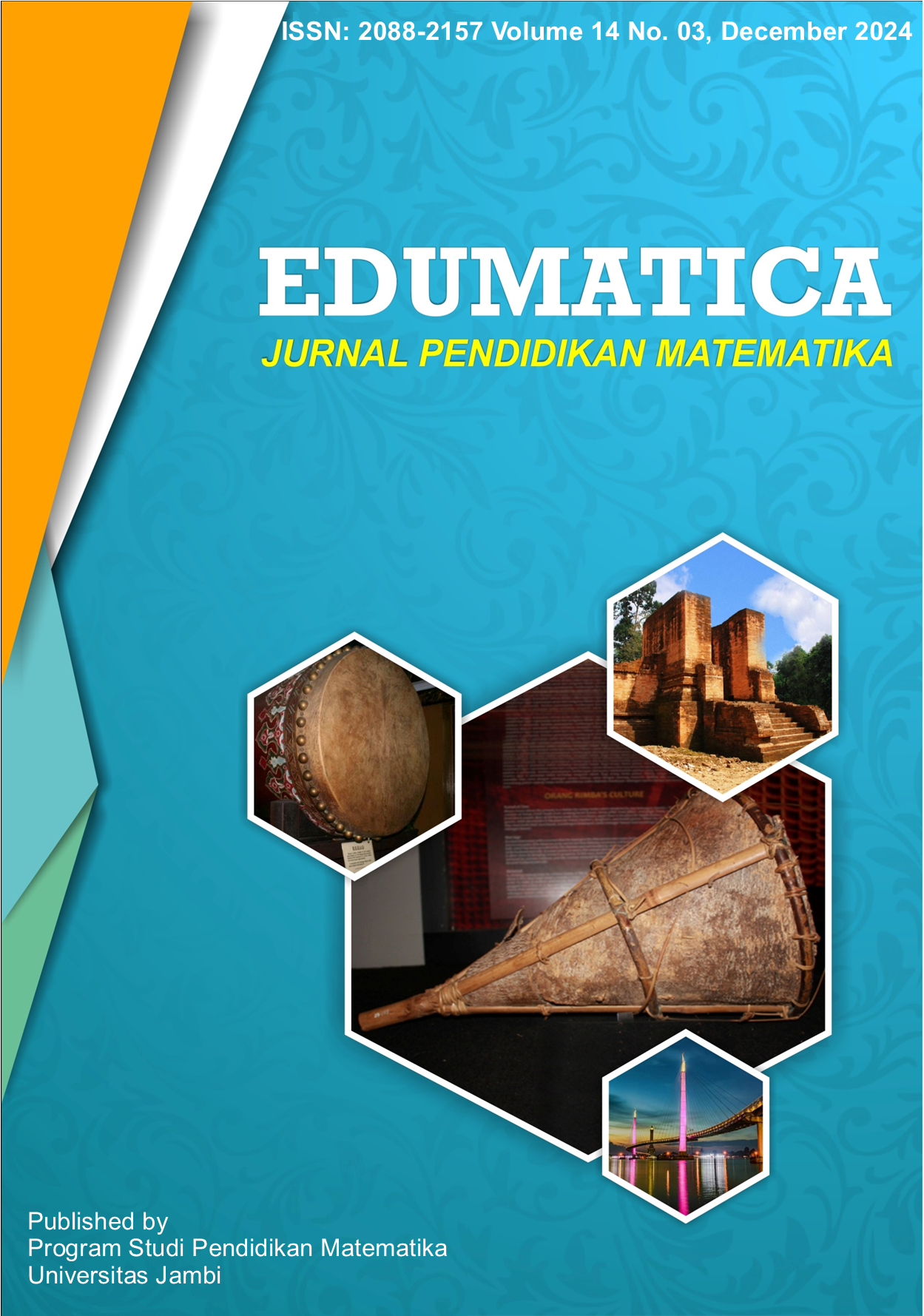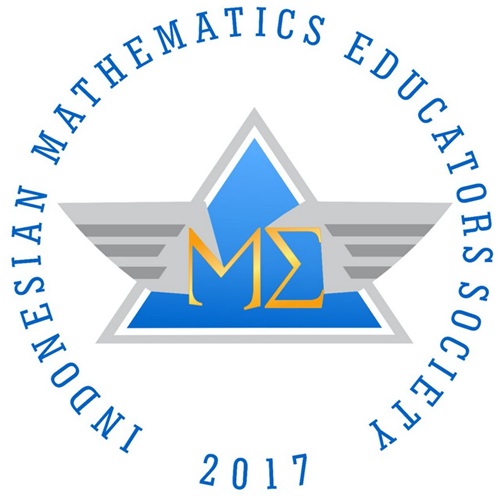The Use of Concrete-Pictorial-Abstract Approach to Enhance Learners’ Conceptual Understanding of Fractions
DOI:
https://doi.org/10.22437/edumatica.v14i3.37168Keywords:
concrete-pictorial-abstract approach, conceptual understanding, fractions, mixed method approach, one-phase concurrent embedded designAbstract
In this paper, we explored how using the Concrete-Pictorial-Abstract (CPA) approach enhances learners’ conceptual understanding of fractions in the Capricorn North District of South Africa. The research is framed within the conceptual understanding theory rooted in cognitive constructivism. Conceptual learning is understanding mathematical ideas as an integrated and functional system with three components: comprehension, operations, and relations. A one-phase concurrent embedded mixed-method research design was used to gather qualitative data through task-based interviews and quantitative data through pretests and post-tests. Deductive thematic analysis was used to analyse the qualitative data. The quantitative data was analysed using descriptive statistics, independent and paired samples T-tests. Seventy (70) conveniently sampled Grade 7 learners participated in the study. The findings indicate that the CPA approach enhanced the learners’ conceptual understanding of fractions though the effect size of the intervention is minimal and negligible. Furthermore, the study found that the incorporation of concrete objects and visual aids proved to be efficient. Additionally, the qualitative results revealed how learners’ conceptual understanding of fractions was enhanced during the intervention. This study contributes to innovative teaching methods of fractions, potentially enhancing mathematics performance and inspiring educators to explore new teaching approaches.
Downloads
References
Africa, M., Borboran, M., Guilleno, M.-A., Mendiola, M., Portento, K., Torrefranca, J., & Conde, R. (2020). A lesson study on using the concrete-pictorial-abstract (CPA): Approach in addressing misconceptions in learning fractions. Multidisciplinary Research, 1(1), 1-8. Retrieved from https://journal.evsu.edu.ph/index.php/sabton-mrj/article/view/218/66
Akinoso, S.O. (2012). Effects of concrete-representational-abstract and explicit instructional strategies on senior secondary school students’ achievement in and attitude to mathematics. A PhD Post-Field Report presented at the Joint Staff/Higher Degree Students Seminar, Department of Teacher education, University of Ibadan, Ibadan.
Baidoo, J. (2019). Dealing with grade 10 learners’ misconceptions and errors when simplifying algebraic fractions. Journal of Emerging Trends in Educational Research and Policy Studies (JETERAPS), 10(1), 47-55. https://hdl.handle.net/10520/EJC-17aa794007
Bailey, D. H., Zhou, X., Zhang, Y., Cui, J., Fuchs, L. S., Jordan, N. C., Gersten, R., & Siegler, R. S. (2015). Development of fraction concepts and procedures in U.S. and Chinese children. Journal of Experimental Child Psychology, 129, 68. https://doi.org/10.1016/j.jecp.2014.08.006
Braun, V., & Clarke, V. (2012). Thematic analysis. In APA handbook of Research Methods in psychology (Vol. 2, pp. 57-71). Washington DC: American Psychological Association.
Cobb, P., & Bauersfeld, H. (2003). The emergence of mathematical meaning: Interaction in classroom cultures. Routledge.
Cohen, L., Manion, L., & Morrison, K. (2018). Research methods in education (8th ed.). New York
Creswell, J. W. (2008). Research design: Qualitative, quantitative, and mixed methods approaches, 3rd ed. Sage Publications, Inc.
Department of Basic Education. (2018). Mathematics Teaching and Learning
Framework for South Africa. Government printing works: Pretoria
Department of Basic Education. (2022). Diagnostic report. Government printing works: Pretoria
Getenet, S., & Callingham, R. (2017). Teaching Fractions for Understanding: Addressing interrelated concepts. 40 years on We are still learning! Proceedings of the 40th annual conference of the mathematics education research group of Australia (pp. 277-284). Melbourne: MERGA.
Kilpatrick, J., Swafford, A., & Findell, B. (2001). Adding it up: Helping children learn mathematics. Washington: National Research Council.
Lestiana, H. T., Rejeki, S., & Setyawan, F. (2016). Identifying learners’ errors on fractions. Journal of Research and Advances in Mathematics Education, 1(2), 131-139. https://doi.org/10.23917/jramathedu.v1i2.3396
Lutfi, J. S., & Dasari, D. (2024). Research trends on learning mathematics with the CPA (Concrete-Pictorial-Abstract) approach. Prisma, 13(1)https://doi.org/10.35194/jp.v13i1.3947
Madzore, E. (2023). The Impact of Learning Mathematical Vocabulary of Functions Using the Frayer Model on Conceptual Understanding and Mathematical Performance of Grade 11 Learners ( Thesis)
Makhubele, Y. E. (2021). The analysis of grade fractions errors displayed by learners due to deficient mastery of prerequisite concepts. International Electronic Journal of Mathematics Education, 16(3), 1-15. https://doi.org/10.29333/iejme/11004
Maoto, S., Masha, K., & Maphutha, K. (2016). Where is the bigger picture in the teaching and learning of mathematics? Pythagoras, 37(1), a338. https://doi.org/10.4102/pythagoras.v37i1.338
Mayer, R. E. (2009). Multimedia Learning (Vol. 2). New York, United States of America: Cambridge University Press. Retrieved from www.cambridge.org
Mills, J. (2016). Developing a conceptual understanding of fractions with year five and six learners. Opening up mathematics education research (Proceedings of the 39th annual conference of the mathematics education research group of Australsia) (pp. 479-486). Adelaide: MERGA.
Minarti, E., & Wahyudin, W. (2019). Conceptual understanding and mathematical disposition of college learner through Concrete-Representational-Abstract approach (CRA). Journal of Physics: Conference Series, 1157, 042124. https://doi.org/10.1088/1742-6596/1157/4/042124
Mntunjani, L. M., Adendorff, S. A., & Siyepu, S. W. (2018). Foundation phase teachers’ use of manipulatives to teach number concepts: A critical analysis. South African Journal of Childhood Education, 8(1)https://doi.org/10.4102/sajce.v8i1.495
Morano, S., Flores, M. M., Hinton, V., & Meyer, J. (2020). A comparison of concrete-representational-abstract and concrete-representational-abstract-integrated fraction interventions for learners with disabilities. Exceptionality, 28(2), 77–91. https://doi.org/10.1080/09362835.2020.1727328
Naidoo, J., & Hajaree, S. (2021). Exploring the perceptions of Grade 5 learners about the use of videos and PowerPoint presentations when learning fractions in mathematics. South African Journal of Childhood Education, 11(1)https://doi.org/10.4102/sajce.v11i1.846
Nainggolan, E. (2022). The application of the concrete-pictorial-abstract (CPA) approach to improve responsibility, conceptual understanding, and mathematical problem-solving skills at sds xyz jakarta]. JOHME: Journal of Holistic Mathematics Education, 6(1), 107-121. https://dx.doi.org/10.19166/johme.v6i1.4527
Ollesch, J., Grunig, F., Dorfler, T., & Heidelberg, M. (2017). Teachingmathematicswithmultimedia-based-representations-what about teachers competencies? doi:https://hal.archives-ouvertes.fr/hal-01950542
Putri, E., Misnarti, & Saptini, R. D. (2018). Influence of concrete-pictorial-abstract (CPA) approach towards the enhancement of mathematical connection ability of elementary school learners. Jurnal Pendidikan Dasar, 10(2), 61-71. https://doi.org/10.17509/eh.v10i2.10915
Putri, H. E., Suwangsih, E., Rahayu, P., Nikawanti, G., Enzelina, E., & Wahyudy, M. A. (2020, April). Influence of Concrete-Pictorial-Abstract (CPA) Approach on the Enhancement of Primary School Students' Mathematical Reasoning Ability. In Elementary School Forum (Mimbar Sekolah Dasar) (Vol. 7, No. 1, pp. 119-132). https://doi.org/10.17509/mimbar-sd.v7i1.22574.
Salingay & Tan D. A.(2018) .Concrete-Pictorial-Abstract Approach On Learners' Attitude And Performance In Mathematics. IOP Conf. Series: Journal of Physics: Conf. Series 1320 (2019) 012008 IOP Publishing. https://doi:10.1088/1742-6596/1320/1/012008
Sumartini, T., & Priatna, N. (2018). Identify learner mathematical understanding ability through direct learning model. Journal of Physics: Conference Series, 1132, 012043. https://doi.org/10.1088/1742-6596/1132/1/012043
Van de Walle, J.A., Karp, K.S., & Bay-Williams, J.M. (2020). Developing fraction operations. In Elementary and Middle School Mathematics: Teaching Developmentally (pp. 415-446). London: Pearson Publishers.
Wiest, L. R., & Amankonah, F. O. (2019). Conceptual versus procedural approaches to ordering fractions. European Journal of Science and Mathematics Education, 7(1), 61-72.
Yuliyanto, A., Turmudi, T., Agustin, M., Muqodas, I., & Putri, H. E. (2020). The relationship of self-efficacy with student mathematics learning outcomes through the concrete-pictorial-abstract (CPA) approach in primary schools. JPSD (Jurnal Pendidikan Sekolah Dasar), 6(1), 1-14. http://dx.doi.org/10.30870/jpsd.v6i1.7213.g5065
Zhang, Q. (2016, July). The teaching of fractions in elementary schools based on an understanding of different sub-constructs. In Proceedings of the 13th International Congress on Mathematical Education (pp. 51-54).
Zhang, S., Yu, S., Xiao, J., Liu, Y., & Jiang, T. (2022). Sequence instruction on fractions for Chinese elementary learners with Mathematics learning disabilities. International Journal of Science and Mathematics Education, 1481-1498. https://doi.org/10.1007/s10763-021-10215-9
Downloads
Published
How to Cite
Issue
Section
License
Copyright (c) 2024 Leboho Sello, Kgaladi Maphutha, Mutodi Paul

This work is licensed under a Creative Commons Attribution-NonCommercial-ShareAlike 4.0 International License.







